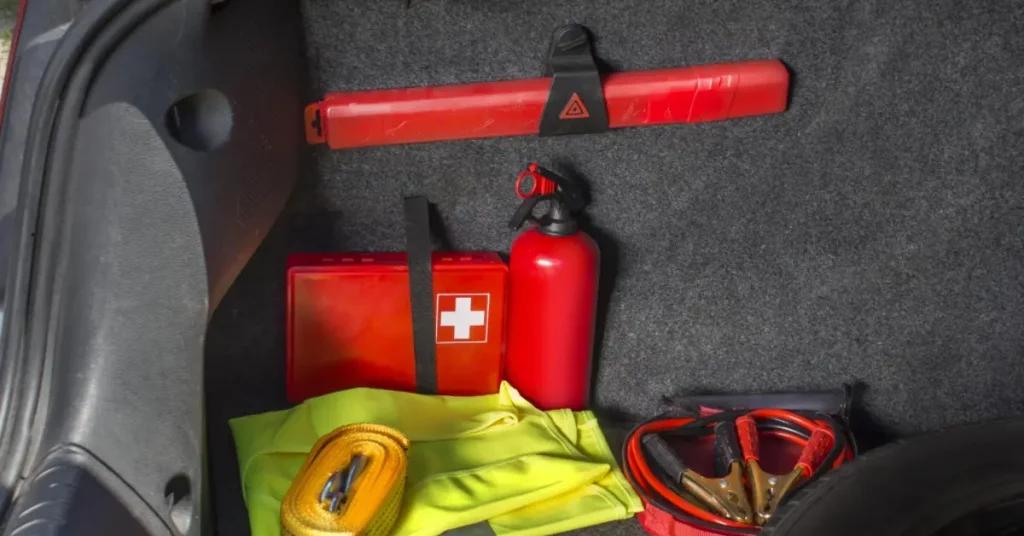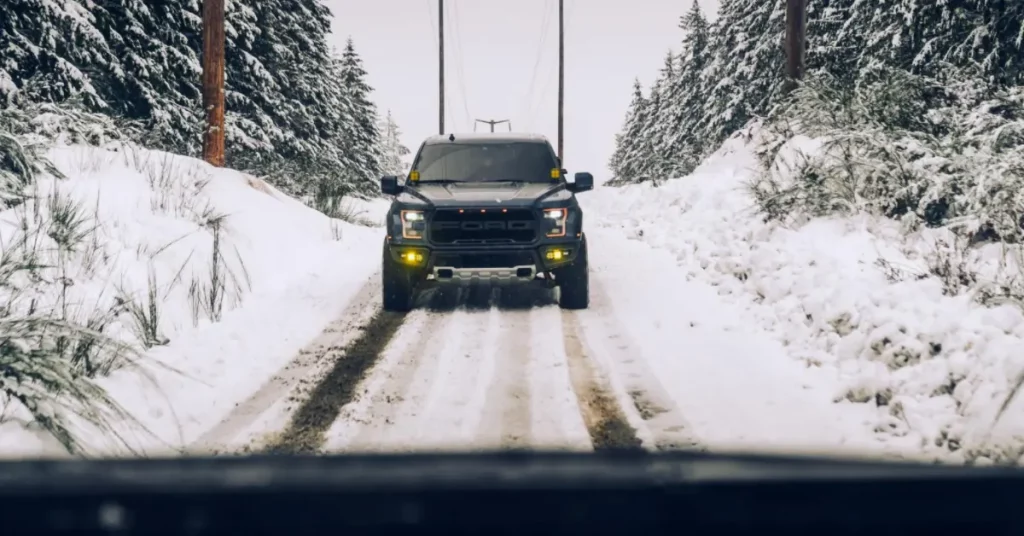7 min read
Key Takeaways
- Ensure safe winter driving by preparing for harsh conditions.
- Stock essential winter supplies for emergency situations.
- Keep your vehicle winter-ready through proper maintenance.
- Pack warm clothes and essentials to stay safe in cold weather.
- Practice safe driving habits to navigate winter roads carefully.
When the weather turns cold and wintry, motorists need to take extra precautions for safe winter driving and handling hazardous road conditions.
Being properly prepared with the right winter driving equipment and supplies can help keep you safe on snow and ice-covered roads.
Follow this winter driving checklist to make sure you and your vehicle are fully prepared for safe winter driving and whatever winter weather comes your way.
Essential Winter Emergency Supplies
Having the right gear and emergency equipment in your vehicle provides comfort and safety if you get stranded in cold weather. Here are some must-have supplies:
- Ice scraper – Keep a sturdy scraper to clear frost, snow, and ice from windows. Trying to drive with limited visibility is dangerous.
- Snow brush – Brush off all snow from your car before driving. Packed snow can obstruct vision and fly off at higher speeds.
- Deicer – Keep deicer spray to melt ice on door handles, windows, and mirrors.
- Winter windshield fluid – Use special fluid that resists freezing in frigid temps.
- Jumper cables – Cables to jump a dead battery in cold weather.
- Emergency kit – Pack a winter kit with warning triangles, a flashlight, snacks, water, gloves, a blanket, medications, etc.
Having these crucial supplies on hand gives you the tools to handle common winter driving hazards and safely operate your vehicle.
Vehicle Maintenance and Checks
To optimize your vehicle for winter driving, have it serviced to handle slippery road conditions and low visibility:
- Windshield wipers – Replace worn wiper blades for optimal snow and rain clearance.
- Battery – Cold temperature drops sap battery power. Test it is fully charged and serviced.
- Tires – Check winter tire tread depth. Inflate to proper pressure.
- Oil – Switch to low-viscosity winter oil for cold starts.
- Coolant – Use antifreeze/coolant formulated for winter temps.
- Brakes – Test pad depth and fluid levels. Change brake fluid if needed.
- Lights – Replace burnt-out headlights, brake lights, signals, etc.
Taking care of these maintenance items will help your vehicle handle winter driving conditions.
Stock Winter Gear
In addition to a winter emergency kit, stock your vehicle with gear to keep you safe if stranded in cold weather:
- Warm clothes – Pack extra coats, snow pants, boots, hats, and gloves in case you must wait for help outside.
- Hand warmers – Toss chemical warmers into your gloves or pockets for up to 10 hours of warmth.
- Blankets – A fleece blanket or metallic space blanket helps retain body heat if stranded.
- Food and drink – Pack high protein snacks and bottled water to keep energy and hydration up.
- Snow shovel – A compact shovel can dig your car out of snowbanks.
- Traction aid – Keep sand or cat litter to sprinkle around stuck tires for traction.
Loading up on extra winter gear provides protection if you break down in cold weather and must wait for assistance.
Utilize Winter Driving Technologies
Today’s modern vehicles offer helpful technologies and features for winter driving:
- All-wheel drive vehicles better handle slippery surfaces by distributing power to all four wheels.
- Backup cameras provide improved visibility when reversing in bad weather.
- Heated seats and steering wheels quickly take the chill out of the cabin.
- Remote start lets you warm up the interior before getting in.
These winter driving aids promote safety and comfort during the cold season.
Equip Your Vehicle with Snow Tires
For maximum winter traction, install four snow tires on your vehicle. Here’s how they outperform all seasons:
- The softer rubber and deeper treads of snow tires provide a superior grip on packed snow and ice.
- All-season tires harden and lose pliability below 45°F, reducing traction.
- Snow tires channel away slush so the tread maintains contact with the road.
Snow tires supply the extra braking power, traction, and handling ability you need to drive safely on winter roads. The enhanced performance lets you accelerate, steer, and stop with control on ice and snow.
Carry Tire Chains for Heavy Snow
Tire chains wrap around tires to dig into deep snow and ice providing enhanced mobility.
Check local regulations – some areas restrict metal chains or limit their use to certain conditions or locations only. Where prohibited, cable chains can provide an alternative solution.
Practice installing tire chains at home before needed roadside. Keep gloves, knee protection, and a rag to ease installation in winter conditions.
Adjust Driving Habits
Along with proper equipment, you need to alter driving habits to account for hazardous winter roadway conditions:
- Allow ample following distance for increased stopping time on slick surfaces. Apply the brake pedal cautiously.
- Avoid sudden braking or acceleration that can cause skidding.
- Approach hills and turns with caution. Use lower gears for improved traction.
- Don’t use cruise control on icy roads – you need active control of speed.
- Clear all windows fully before driving for maximum visibility.
- Use fog lights in heavy snow and low visibility for better vision.
- Watch for black ice on seemingly clear roads, especially on bridges where ice forms first.
Adjusting driving habits for winter road hazards keeps you safe all season long. Stay alert for changing weather conditions.

Pack a Winter Emergency Driving Kit
A well-stocked emergency kit provides critical items if you break down or get stuck in severe winter weather:
- Ice scraper, snow brush
- Jumper cables, road flares
- Flashlight and spare batteries
- High-calorie snacks – protein bars, nuts, chocolate
- Bottled water and juice boxes
- Hand warmers and emergency space blanket
- Tissues, paper towels
- Basic tools – duct tape, zip ties, multi-tool
- Cell phone charger
- Sand or cat litter for traction
- Collapsible shovel
Having these must-have items on hand will provide safety and comfort until you receive assistance. Prepare winter driving emergency kits for all vehicles.
Use Remote Starters Cautiously
Many newer vehicles have remote start capabilities that allow you to start the engine and warm up or cool down the interior from afar. While remote start makes winter driving more comfortable, keep these safety tips in mind:
- Never remotely start a vehicle in an enclosed garage due to exhaust buildup and risk of carbon monoxide.
- Don’t let vehicles idle unattended for more than 5-10 minutes.
- Ensure doors are locked after doing a remote start.
- Keep key fobs safely away from children.
Following remote starter precautions prevents potential hazards.
Take Safety Steps in Winter Storms
When a major snowstorm strikes, take preventative action to stay safe:
- Avoid driving if at all possible during heavy snowfall and whiteout conditions.
- Drive slowly with hazard lights on if you must go out. Don’t use high beams.
- Tell others your route and ETA in case you need to be checked on.
- Fully charge devices and have backup charging options if stranded.
- Equip your vehicle properly with winter tires, emergency kit, warm clothes, food, water, etc.
- Seek safety at the nearest building if conditions deteriorate.
Following winter storm safety tips prevents you from venturing into perilous situations on the road. Stay alert to changing weather forecasts and radar.
Drive Safely This Winter
Preparing your vehicle and adjusting your driving habits make all the difference in navigating hazardous winter conditions safely. Follow these winter driving tips to avoid dangerous situations on cold, snowy, and icy roads. With proper precautions, you can drive confidently no matter what winter throws your way.
Stay warm, stay safe, and get where you need to go – no matter how old man winter blusters and blows!



